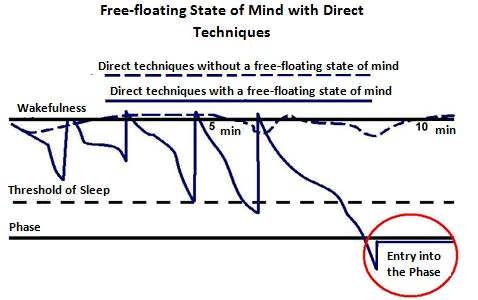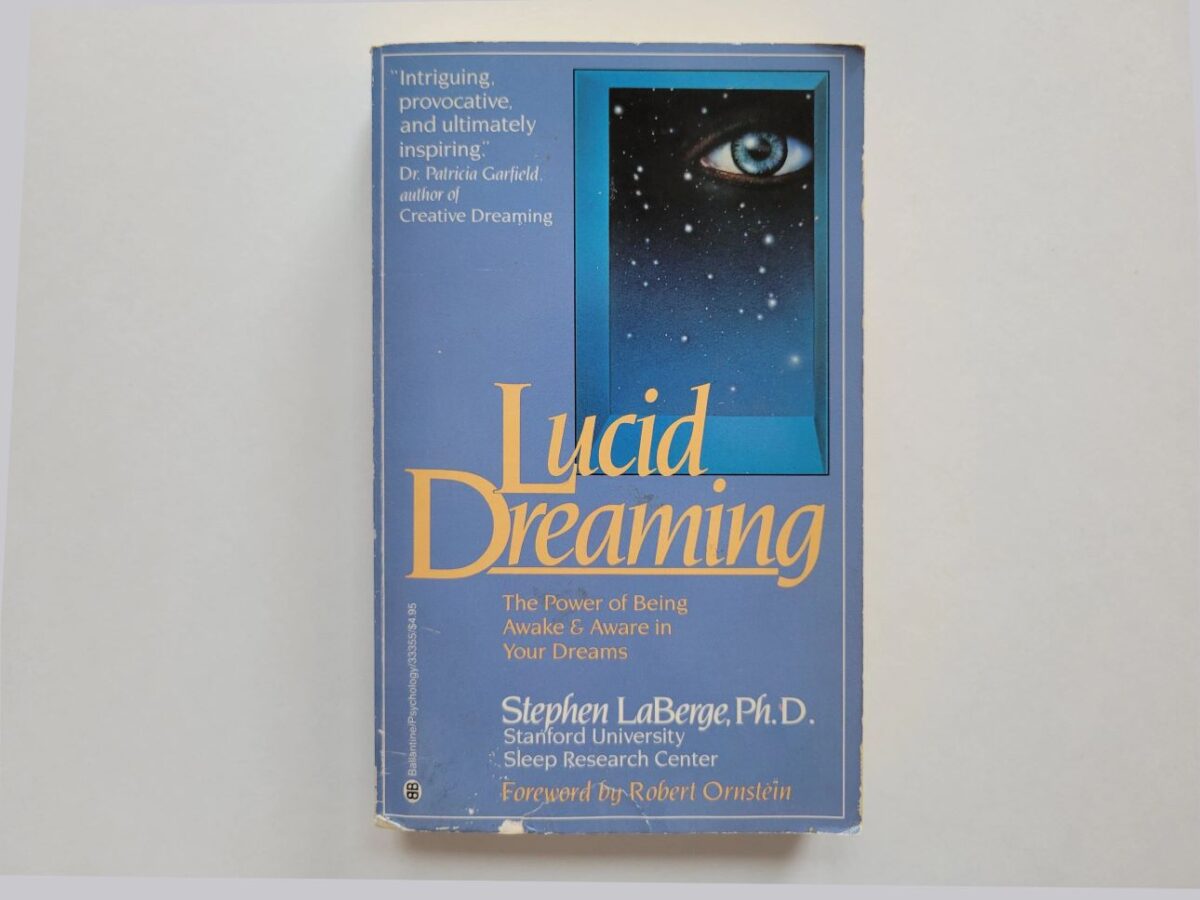As soon as indicators of a foul appear, immediately lie down on the floor and attempt forced falling asleep; the same as lucid dreaming entry technique. After successfully performing the technique (3-10sec.) , a practitioner may get up and continue to travel through lucid dreaming since the perception of reality and its depth will most likely be restored. Resist actually fall asleep.
The techniques detailed below may be used both with a direct method of entering lucid dreaming without prior sleep, and with an indirect method performed upon awakening. The exceptions are the dream consciousness techniques, which are listed separately, although they cannot but have a direct influence on the probability of success of the other methods. Conversely, all of the other techniques cannot but have the side effect of increasing the probability of dream consciousness arising. With a few exceptions, the list does not include non-autonomous lucid dreaming entrance techniques based on external physical factors or chemical influences.
The specifics of using each method are described in detail in its corresponding section. All of the techniques listed below are to be used in accordance with the instructions for each method. However, it is necessary to first understand a fundamental difference here. With an indirect method upon awakening, the goal is to find a technique that works by quickly alternating through the most interesting and intuitive ones. As soon as a technique starts working, keep with it and intensify the effort, and then try to separate right away. It will become apparent how well a technique is working by the intensity of its effects. For example, some imagined movement may become real. Any real sensations arising from the techniques upon awakening mean that they are working, and that the practitioner is already in lucid dreaming.
The techniques play a secondary role with the direct method, and serve to create a free-floating state of mind (fading out or activating consciousness, depending on the type of technique being performed) that is conducive to brief lapses in consciousness. The deeper a lapse, the better the chances of immediately entering lucid dreaming when resurfacing from it. Meanwhile, techniques may work from beginning to end. However, this means nothing without lapses in consciousness, unlike with indirect techniques.
It’s also important to remember that direct techniques performed without prior sleep have one-tenth the success rate of indirect ones performed upon awakening. That’s why all the techniques below can easily bring results upon awakening, but be useless for novices when used at other times.
Each technique is described only in general terms, and it is assumed that the practitioner already has a basic understanding of all of the mechanisms by which lucid dreaming occurs and is able to fill in all of the additional nuances on his own.
Several technique-based tricks can be used to substantially improve the odds of success of practically all of the techniques listed below. First, you should try to not simply perform the techniques "for the sake of appearances", but rather give them your all, trying to become one with them and put all of your sensations into them. Next, you can move your gaze up slightly, as naturally as possible. Third, begin to use the techniques by first imagining yourself doing a 180 degree turn along your head-to-toe axis. Fourth, while you’re performing your techniques always try to recall sensations of how they had already worked in the past, or of past lucid dreaming occurrences. Fifth, you should always have a clear motivation for entering lucid dreaming. That motivation may perhaps arise from the most interesting plan of action you can think of.
Encounters
With relatives: Since relatives cannot always see each other, there is the remarkable possibility to meet each other and talk in lucid dreaming. Of course, this does not entail mutual presence. It is enough for one person to possess the required desire – the second person may never even know. Realizing the desire to contact a close relative and exchange information is a treasure.
With acquaintances: Circumstances often prevent seeing people who are important. This is an opportunity to realize a desire and finally meet that certain person again.
With the dead: Regardless of the nature of lucid dreaming phenomenon, nothing else yields the possibility to see, talk to, and embrace a deceased loved one. These are vivid, personal experiences, accessible to everyone, and achieving these encounters does not require major difficulty. Courage is the only necessity. From a technique-related point of view, a stable lucid dreaming and application of the finding objects technique sets the stage for what at first may seem impossible. It should be noted that when a deceased person is encountered in lucid dreaming, the distortions caused by the object finding technique may lead to some very undesirable occurrences.
With celebrities: Through the use of object finding techniques, a practitioner has the opportunity to meet any famous person. This could be a historical persona, a contemporary politician, or an artist. In lucid dreaming state, they are all accessible for any type of interaction. For example, a practitioner could meet Julius Caesar, Jesus Christ, Napoleon, Churchill, Stalin, Hitler, Elvis Presley, Marilyn Monroe, and a great many others.
John Merritt
Houston, USA
A friend of mine found A Practical Guidebook on the net and sent me the link. I read the book, and soon it finally happened.
I went to sleep around 10 or 11 and woke up at 4. I stayed up for 30 minutes and lay back down. I started meditating, and then going over the techniques and separation in my mind. I fell into a free floating state, going in and out of consciousness. I started observing images. And soon vibrations started. I had already experienced vibrations once or twice. The first time I felt them I was scared and they went away after a few seconds. The second time I tried to intensify them and it seemed to work for a few seconds, but then again nothing. This time I used straining the brain and the vibrations got stronger and stronger. And this time I didn’t lose them. They intensified and came to a crescendo, and when they were over, I felt different. My next thought was I was already separated from my body. All I had to do was just stand up! And I was right.
I rose up out of my body and sat up and stepped off the bed and I was out! I hadn’t really planned what I would do (M.R.: no deepening and no plan of action). The room was dark, and my first thought was to turn on a light. I was in my bedroom so I walked into the bathroom in my bedroom and flipped the light switch on. Nothing. I vaguely thought to myself, “maybe the light is burned out”, so I walked out into the hallway and into the other upstairs bathroom and turned on that light switch. Again nothing. But I remembered then from reading lucid dreaming books that light switches don’t work in dreams. And since I was in my astral body turning on the light switch wasn’t going to work either.
I decided to go back to my bed and look at myself. I ran into the room saw my bed and literally jumped up on the footboard and looked. And there I was. Or there my body was. And it was the most incredible feeling I’d ever experienced in my life. I was outside my body and I knew it. I was wide awake, fully conscious, with all my essence, memories, all of me. But there it was asleep on the bed. My physical body. I even saw one of my arms jerk a little. After that I felt the need to verify what had just happened, and see if I could remember it. Soon I was back in my body and wide awake (M.R.: no re-entering). And it was true. It had really happened. At last I had done it. And it was real. And I remembered every second of it.
THE FREE-FLOATING STATE OF MIND
There are almost infinite descriptions of direct entry techniques offered in literature, stories, on the Internet, and at seminars. Sometimes, one description fundamentally differs from another. In the majority of cases, however, common threads exist that unite almost every description of a particular technique: short lapses in consciousness, memory gaps, and drifting in and out of sleep, all of which are hallmarks of the free-floating state of mind. After any of these phenomena occur, all manner of unusual pre-lucid dreaming or lucid dreaming sensations arise.
Lapses in consciousness may last for seconds, several minutes, or more than an hour. They may range from a simple loss of consciousness to entrance into a full-fledged dream. They may be singular and rare, or may occur several times over the course of a minute. Whatever a lapse entails, the mind attains a mode of operating that is ideal for lucid dreaming experimentation, provided the practitioner is able to refrain from deep sleep and quickly return to a conscious, waking state.
Not every lapse of consciousness leads to lucid dreaming. The lapse must have sufficient depth to be effective. Thus, with every unsuccessful lapse, another deeper lapse should be incurred.

The primary practical drawback of the free-floating state of mind is the possibility of falling completely asleep during lapses instead of only temporarily dipping into sleep. Techniques are definitely necessary to ensure the desired result. Such techniques more or less fulfill an auxiliary function, and thus one need not be strict about them.
Interesting Fact!
It does not matter which direct technique is used; as long as it leads to lapses in consciousness, success is possible.
When performing the variations of the techniques, a practitioner can begin to vacillate between full alertness and complete asleep, coming to, and then nodding off again.
To avoid falling asleep requires a strong desire to return to wakefulness. This is accomplished by a strong resolve on the part of the practitioner, even if, while performing a direct technique, drifting in and out of sleep occurs. The practitioner must firmly assert that at the moment consciousness tapers off, awakening will immediately occur.
On the other hand, if lapses do not occur, and are replaced by complete alertness, the following tricks of the trade may help: full concentration on mental actions or, conversely, musing and daydreaming in parallel with the technique being used. It should be noted that these are only effective at the initial stages of working with direct techniques since such techniques have a strong sleep-inducing effect.
If direct techniques do not lead to light sleep or singular lapses after a long period of regular practice, then it must be assumed that the practitioner is dealing with some appreciable error in technique or in the length of performance.
The number of lapses that occur may be regulated by body position during practice or by changing the variation used while performing techniques.
Entering lucid dreaming with a free-floating state of mind most often occurs as the result of three key factors. First, one technique or another may begin to work well during a lapse. Second, nearness to lucid dreaming may unexpectedly manifest itself through sounds or vibration after a lapse. During this, transitioning to techniques that correspond to the above symptoms (listening in, straining the brain) may be applied. Third, when exiting a lapse, it is sometimes easy to separate or quickly find a working technique by paying attention to initial indicators.
Interesting Fact!
There is a theory that there is no such thing as a direct lucid dreaming entrance method, and that all direct methods are actually a subcategory of the indirect method. The only difference would be that direct techniques involve inducing micro-sleep, which authentically mimics falling asleep, creating a physiological state closer to natural awakening, when it is easy to enter lucid dreaming.
Lapses in consciousness are not bound to occur in 100% of cases. However, striving to achieve lapses plays a very important role since they are not always perceivable, and a lapse occurrence is not always obvious. They can be very short in duration or shallow. Or, they may not occur at all. Nonetheless, properly applied techniques to produce lapses may give entrance to lucid dreaming. This is especially true of the deferred method for direct lucid dreaming entrance. It is also worth noting that lapses in consciousness can be so shallow and brief that a lucid dreamr may simply be unable to recognize them.









